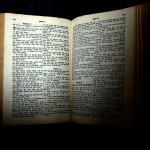Some time ago, quite some time ago, actually, Eric asked if I’d do a bit of exegesis of a passage in 1 John to illustrate the activities involved. I don’t remember quite what passage we agreed on, but I think it was the first substantive section of the First Epistle of John, 1 John 1:5-2:17.
So here we go…
GENRE
The first stop is genre. A literary genre is a group of texts that exhibit a coherent and recurring pattern of features, usually further defined in terms of form, content, and function. The nice thing about placing a text in a literary genre is that it gives us some idea of what to expect, although most authors subvert the conventions of genre to one degree or another. And that, in itself, is often very illuminating.
The title of the work in question is “The First Epistle of John.” This is a fine title except for the fact that it’s not an epistle (there’s no addressee or sender, no salutation and no closing) and there’s no indication it was written by anyone named John, let alone the prominent disciple of Jesus by that name. In fact, there’s no indication at all to tell us who wrote it. From the standpoint of genre the First Epistle of John resembles the Epistle of Paul to the Hebrews more closely than any other NT work. And like 1 John, the Epistle of Paul to the Hebrews is not an epistle, was not written by Paul, and is not addressed to the Hebrews. Other than that, though, it’s a great title.
OK, that was illuminating…
What might provide some light on the situation are the two pieces of evidence that suggest that 2 John was the cover letter for 1 John. 2 John has much in common with Greco-Roman personal letters: it’s short, personal, and informal. However, it’s not quite a personal letter because it’s probably addressed to a group rather than a person:
The elder to the elect lady and her children, whom I love in the truth, and not only I but also all who know the truth, 2 because of the truth that abides in us and will be with us forever: 3 Grace, mercy, and peace will be with us from God the Father and from Jesus Christ, the Father’s Son, in truth and love.
The sender identifies himself as “the elder” and he writes to “the elect lady and her children.” Now take a look at the letter’s closing:
13 The children of your elect sister send you their greetings.
It is possible that this is a friendly warning between cousins about the growing challenges of achieving multicultural harmony in an area with a significant antichrist presence. It is more likely, however, that “the elect lady” is actually another church in the Johannine community and “her children” are the members.
What is indubitably the case is that 1 John and 2 John are concerned about much the same thing, indeed, 2 John (245 words) is something of a synopsis of 1 John (2,137 words). The other interesting bit of information is that Irenaeus (d. 202 CE) quotes 2 John 7, 8 with 1 John 4:1-3 and 5:1 as if they were from the same letter. So it is possible that 1 John was a bit of a message from someone called “the elder” sent round under 2 John to other churches in the Johannine community.
THE AUTHOR
We will call the author of 1 John “the Elder.” Asking about the identity of an author is part of trying to determine the historical and cultural context of a work. In a text like 1 John, which has no explicit identification, the potential for circular arguments is always close at hand. Since, however, the interpretive rewards associated with knowing this sort of information are so significant, we persevere.
So what do we know about the Elder? Not much. From the internal evidence, he speaks with a certain amount of authority. Sometimes this authority places him as part of an authoritative group, as in the prologue (1 John 1:1-4):
We declare to you what was from the beginning, what we have heard, what we have seen with our eyes, what we have looked at and touched with our hands, concerning the word of life– 2 this life was revealed, and we have seen it and testify to it, and declare to you the eternal life that was with the Father and was revealed to us– 3 we declare to you what we have seen and heard so that you also may have fellowship with us; and truly our fellowship is with the Father and with his Son Jesus Christ. 4 We are writing these things so that our joy may be complete.
That’s an interesting use of “our” in that last sentence, isn’t it? Anyway, sometimes he uses “we” in a way that includes both he and his readers (1 John 3:11-12):
11 For this is the message you have heard from the beginning, that we should love one another. 12 We must not be like Cain who was from the evil one and murdered his brother. And why did he murder him? Because his own deeds were evil and his brother’s righteous.
He also addresses his readers as “little children,” conveying both authority and a deep concern (1 John 3:18-19):
18 Little children, let us love, not in word or speech, but in truth and action. 19 And by this we will know that we are from the truth and will reassure our hearts before him
And he can use a more egalitarian address, such as “beloved” or “brothers”:
(1 John 3:2) 2 Beloved, we are God’s children now; what we will be has not yet been revealed. What we do know is this: when he is revealed, we will be like him, for we will see him as he is.
(1 John 3:13) 13 Do not be astonished, brothers and sisters, that the world hates you.
What comes through in all these forms of address is a deep sense of his pastoral responsibility. He’s usually considered a member of the Johannine school. In this context, a “school:”
1) is gathered around a founding figure, in this case the Beloved Disciple
2) the founder of the school is a teacher and an exemplar of wisdom or goodness
3) members of the school are disciples of the teacher and loyal to his teaching, in this case the Gospel of John or the oral traditions that would become this work
4) teaching and learning are focal activities of the school
5) common meals commemorate the role of the founder
6) there is an emphasis on brotherly love and fellowship
7) rules define the life of members
8.) the school is somehow “distanced” from the rest of society
9) institutional structures provide for the perpetuation of the school
The Johannine school, then, was related to the Johannine community, a wider network of churches, by their sense of responsibility for these churches. (The Johannine churches apparently don’t have bishops, deacons, or the like, and they don’t worry about the concept of an apostle.) This school was probably also responsible for the final editing and publication of the Gospel of John, including the inclusion of chapter 21 with its announcement of the death of the Beloved Disciple. The challenge that generated the Johannine epistles did not call them into existence but it does appear to have called them into action.
So…if the Elder is a part of the Johannine school. Is he the sole author of the Fourth Gospel or the John identified in the Synoptics as a disciple of Jesus? Probably not. And while we’re at it, he’s not the author of Revelation, either. The best place to go to read more about the traditional identification of John, the son of Zebedee, is R. Alan Culpepper’s John, the Son of Zebedee: the Life of a Legend. Although we will have more to say about the Elder and his links to the Beloved Disciple later on, for now it is sufficient to have identified him with his sense of responsibility for the community.
NEXT UP: The relationship between the Johannine Epistles and the remaining Catholic Epistles, the Gospel of John, and the rest of the NT.











